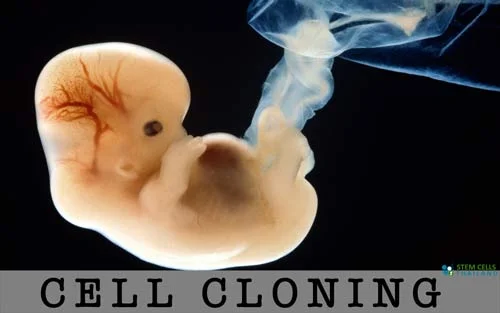
Cloning is the process of generating replicas of a particular cell or organism, or even a portion of DNA.
Cloning a stemcell means to doctors are able to produce a population of cells from just one single cell.[1] The Cloning process produces unspecialized stem cells that are induced or differentiated to grow into various types of adult stem cells. These advances made through cloning embryonic stem cellshave led to revolutionary new regenerative therapies and also to prevent mitochondrial diseases from being passed from mother to child.[2] The development of cloning technology in Thailand has led to new methods of medicine delivery and is improving our understanding of human development and genetics.[3]
There is a lot of ethical debate over whether or not therapeutic cloning should be used. Cloning process is reproduced in vitro through asexually Cloning. This process refers to creating copies of DNA fragments and is also called molecular cloning ), cells (cell cloning), or organisms. Cloning involves producing genetically identical individuals. In the context of humans, cloning is a controversial and ethically charged topic. Two main types of cloning techniques have been discussed in scientific and bioethical contexts: reproductive cloning and therapeutic cloning.
Reproductive cloning aims to produce a genetically identical individual, or a “copy,” using a process known as somatic cell nuclear transfer (SCNT). In SCNT, the nucleus of an egg cell (oocyte) is replaced with the nucleus from a somatic cell (any cell other than a sperm or egg), and the egg is then stimulated to divide and develop into an embryo. The embryo can be implanted in a surrogate to develop into a full organism.
Therapeutic cloning, also known as somatic cell nuclear transfer (SCNT) for the purpose of generating embryonic stem cells, involves the same initial steps as reproductive cloning. However, instead of implanting the embryo to produce a new individual, the embryo is cultivated in vitro to generate stem cells. These stem cells can potentially be used to develop tissues or organs for transplantation.
Both forms of cloning face technical challenges, including low efficiency and the potential for abnormalities in the cloned cells or tissues. While cloning technologies have the potential to revolutionize medicine, they also raise profound ethical, moral, and safety concerns. As with all groundbreaking technologies, there is a need for robust public discussion, rigorous scientific evaluation, and careful regulatory oversight.
Organism cloning or “reproductive cloning” refers to the process of creating a new multicellular organism that is 100% genetically identical to each other. There are also many potential dangers in cloning human cells. Many scientists believe that human cloning is only about 10 or 15 years away still because the process is far more difficult than cloning a sheep. Human reproductive cloning is Banned in most countries and also not allowed in Thailand.[4]
[1] ^Imsoonthornruksa, Sumeth, Chanchao Lorthongpanich, Anawat Sangmalee, Kanokwan Srirattana, Chuti Laowtammathron, Wanchai Tunwattana, Wachiravit Somsa, Mariena Ketudat-Cairns, Takashi Nagai, and Rangsun Parnpai. 2011. The effects of manipulation medium, culture system and recipient cytoplast on in vitro development of intraspecies and intergeneric felid embryos. The Journal of reproduction and development, no. 3 (February 14). https://www.ncbi.nlm.nih.gov/pubmed/21325740
[2] ^ Imsoonthornruksa, Sumeth, Kanokwan Srirattana, Wanwisa Phewsoi, Wanchai Tunwattana, Rangsun Parnpai, and Mariena Ketudat-Cairns. 2012. Segregation of donor cell mitochondrial DNA in gaur-bovine interspecies somatic cell nuclear transfer embryos, fetuses and an offspring. Mitochondrion, no. 5 (July 21). doi:10.1016/j.mito.2012.07.108. https://www.ncbi.nlm.nih.gov/pubmed/22824460
[3] ^ Liu, J, Y Wang, J Su, Y Luo, F Quan, and Y Zhang. 2013. Nuclear donor cell lines considerably influence cloning efficiency and the incidence of large offspring syndrome in bovine somatic cell nuclear transfer. Reproduction in domestic animals = Zuchthygiene, no. 4 (January 16). doi:10.1111/rda.12140. https://www.ncbi.nlm.nih.gov/pubmed/23320388
[4] ^ Imsoonthornruksa, Sumeth, Anawat Sangmalee, Kanokwan Srirattana, Rangsun Parnpai, and Mariena Ketudat-Cairns. 2012. Development of intergeneric and intrageneric somatic cell nuclear transfer (SCNT) cat embryos and the determination of telomere length in cloned offspring. Cellular reprogramming, no. 1 (January 4). doi:10.1089/cell.2011.0054. https://www.ncbi.nlm.nih.gov/pubmed/22217197
If you've seen people take ice baths or cold showers and wondered if they're onto… Read More
Immunomodulation stands at the forefront of biomedical research, steering the immune system's ability to fight… Read More
Stem cell research leads the charge in medical innovation, heralding revolutionary advances in regenerative medicine.… Read More
The blood-brain barrier (BBB) is a crucial shield for the brain, regulating the entry of… Read More
While peptide bonds are fundamental to protein structure, their direct relationship with stem cells lies… Read More
When discussing cutting-edge cancer treatments, NK cell therapy stands out due to its unique approach… Read More